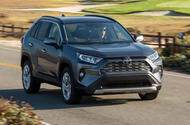
Long-standing SUV enters a new generation - can all-round improvements turn it into a Nissan Qashqai rival? Toyota’s efforts to add interest to the styling of its cars takes another step forward with the all-new, fifth-generation RAV4 SUV, which is certainly more distinctive than its bland predecessor. Some of the polygon-inspired sculpting about this latest RAV4’s flanks might look strange, but the overall effect is of a more dynamic and individual machine.But the overhaul is about a lot more than styling. This new RAV4 uses Toyota’s highly versatile Toyota New Global Architecture (TNGA), which is 57% stiffer in this application, lowers the car’s centre of gravity and provides the sophistication of double-wishbone rear suspension, improved steering feel, optimised weight distribution and a suite of safety features. In spite of the lower centre of gravity, ground clearance increases by 15mm, and the overhangs have been trimmed by extending the wheelbase within a fractionally shorter length.Visibility has been improved, too, by slimming the A-pillars, lowering the beltline, enlarging the side windows, repositioning the door mirrors and optionally offering a camera rear-view mirror that virtually removes the headrest and pillar structures obscuring your view.The effect of all this is to create an airier cabin, and one of subtly and satisfyingly improved tactile quality. There’s more soft-feel trim, interesting upholstery that actually features some colour (a novelty for Toyota), a rubber finish to the door pull handles and climate controls and a leather-capped gearknob. It’s not quite premium, but this is a more interesting, well-made interior and a vast improvement on RAV4s past.The drivetrain is more interesting, too, if you opt for the 2.5-litre hybrid. There’s a 2.0 petrol with manual or automatic gearboxes, but our test car was the 2.5, its lighter, more compact fourth-generation hybrid driveline providing all-wheel drive via a motor/generator on the rear axle. It allows up to 80% of the torque to go to the rear wheels.
 Long-standing SUV enters a new generation - can all-round improvements turn it into a Nissan Qashqai rival? Toyota’s efforts to add interest to the styling of its cars takes another step forward with the all-new, fifth-generation RAV4 SUV, which is certainly more distinctive than its bland predecessor. Some of the polygon-inspired sculpting about this latest RAV4’s flanks might look strange, but the overall effect is of a more dynamic and individual machine.But the overhaul is about a lot more than styling. This new RAV4 uses Toyota’s highly versatile Toyota New Global Architecture (TNGA), which is 57% stiffer in this application, lowers the car’s centre of gravity and provides the sophistication of double-wishbone rear suspension, improved steering feel, optimised weight distribution and a suite of safety features. In spite of the lower centre of gravity, ground clearance increases by 15mm, and the overhangs have been trimmed by extending the wheelbase within a fractionally shorter length.Visibility has been improved, too, by slimming the A-pillars, lowering the beltline, enlarging the side windows, repositioning the door mirrors and optionally offering a camera rear-view mirror that virtually removes the headrest and pillar structures obscuring your view.The effect of all this is to create an airier cabin, and one of subtly and satisfyingly improved tactile quality. There’s more soft-feel trim, interesting upholstery that actually features some colour (a novelty for Toyota), a rubber finish to the door pull handles and climate controls and a leather-capped gearknob. It’s not quite premium, but this is a more interesting, well-made interior and a vast improvement on RAV4s past.The drivetrain is more interesting, too, if you opt for the 2.5-litre hybrid. There’s a 2.0 petrol with manual or automatic gearboxes, but our test car was the 2.5, its lighter, more compact fourth-generation hybrid driveline providing all-wheel drive via a motor/generator on the rear axle. It allows up to 80% of the torque to go to the rear wheels.
Long-standing SUV enters a new generation - can all-round improvements turn it into a Nissan Qashqai rival? Toyota’s efforts to add interest to the styling of its cars takes another step forward with the all-new, fifth-generation RAV4 SUV, which is certainly more distinctive than its bland predecessor. Some of the polygon-inspired sculpting about this latest RAV4’s flanks might look strange, but the overall effect is of a more dynamic and individual machine.But the overhaul is about a lot more than styling. This new RAV4 uses Toyota’s highly versatile Toyota New Global Architecture (TNGA), which is 57% stiffer in this application, lowers the car’s centre of gravity and provides the sophistication of double-wishbone rear suspension, improved steering feel, optimised weight distribution and a suite of safety features. In spite of the lower centre of gravity, ground clearance increases by 15mm, and the overhangs have been trimmed by extending the wheelbase within a fractionally shorter length.Visibility has been improved, too, by slimming the A-pillars, lowering the beltline, enlarging the side windows, repositioning the door mirrors and optionally offering a camera rear-view mirror that virtually removes the headrest and pillar structures obscuring your view.The effect of all this is to create an airier cabin, and one of subtly and satisfyingly improved tactile quality. There’s more soft-feel trim, interesting upholstery that actually features some colour (a novelty for Toyota), a rubber finish to the door pull handles and climate controls and a leather-capped gearknob. It’s not quite premium, but this is a more interesting, well-made interior and a vast improvement on RAV4s past.The drivetrain is more interesting, too, if you opt for the 2.5-litre hybrid. There’s a 2.0 petrol with manual or automatic gearboxes, but our test car was the 2.5, its lighter, more compact fourth-generation hybrid driveline providing all-wheel drive via a motor/generator on the rear axle. It allows up to 80% of the torque to go to the rear wheels.
Comments
Post a Comment